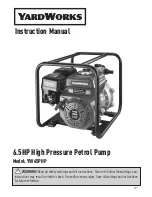
5
8 2 2 5 5 L
D E S C R I P T O N
Taps and dies are tools of high precision. They are produced from high-quality alloy steel, heat treated
and tempered for a hardness of 58-61 HRC. Check the hardness of your workpiece before starting
thread-cutting by a regular machinist`s file. In case the workpiece can be easily filed, you may proceed
with your thread-cutting.
TA P S ( F O R I N T E R N A L T H R E A D S )
To cut an internal thread, select a proper drill-size as per the table shown below, the tap of the desired
size, tap-wrench and cutting-oil. The proper hole-size is very important in the formation of good
threads. An oversized hole results in reduced thread-hight, an undersized hole will overload the tap
and will probably cause demage of the tool or even the workpiece. Please refer to the table printed
below concerning the correct size of drill. Fix the workpiece in a bench-vise or by using clamps.
Secure the tap by the square in the tap-wrench and start threading by turning the wrench in
clockwise direction. Great care must be taken to start the tap square to the hole. As the tap is turned it
bites into the metal and Ieads into the hole. After the tap has been started, the metal-chips, that flow
into the flute spaces, must be broken to relieve pressure on the tap. This is accomplished by reversing
the tap-direction every 1/4 to 1/2 revolution depending on the tightness encountered. Providing
lubrication to the cutting edges while tapping will result in smoother threads and Ionger tap-life.
Continue threading until the tap passes through the workpiece or it reaches the bottom of the hole.
When tapping a blind hole (one that does not pass entirely through the workpiece) take care in drilling
to provide clearance at the bottom for metal-chips and the starter-threads. These chamfered threads
on the end of the tap will not cut full threads.
D I E S ( F O R E X T E R N A L T H R E A D S )
To cut an external thread, such as on a bolt, select the correct die for the rod, being threaded, the die-
stock and cutting-oil. The size of the rod or bolt is of great importance. lt must not be larger than the
desired thread and preferably 005“ to .010“ undersized. An oversized workpiece may demage the die
and will make turning very difficult. Slightly undersized workpieces are easier to thread and furnishes
enough thread-height for normal use. After securing the part being threaded, insert the die into the
die-stock and run the set screw snugly into one of the recesses in the outside surface of the die. (The
recess and slot pattern of dies allows use with a variety of die stocks). The chamfered side of the die
is used for starting the threading operation. Always bevel the end of the bolt or rod to be threaded,
to make angles starting easier. This filed or ground chamfer also helps in starting at right to the work,
which is of major importance. Start the die on the rod with clockwise rotation until it begins leading
onto the workpiece. Metal-chips will flow into the holes provided and should be broken by reversing
the direction every 1/4 to 1/2 revolution, depending on the tightness encountered. Continue this
operation until threads of the desired length have been cut. Provide proper lubrication to the
workpiece while cutting threads.
82255L_manual_75160_de_en_roh.indd 5
82255L_manual_75160_de_en_roh.indd 5
30.10.20 09:31
30.10.20 09:31


























